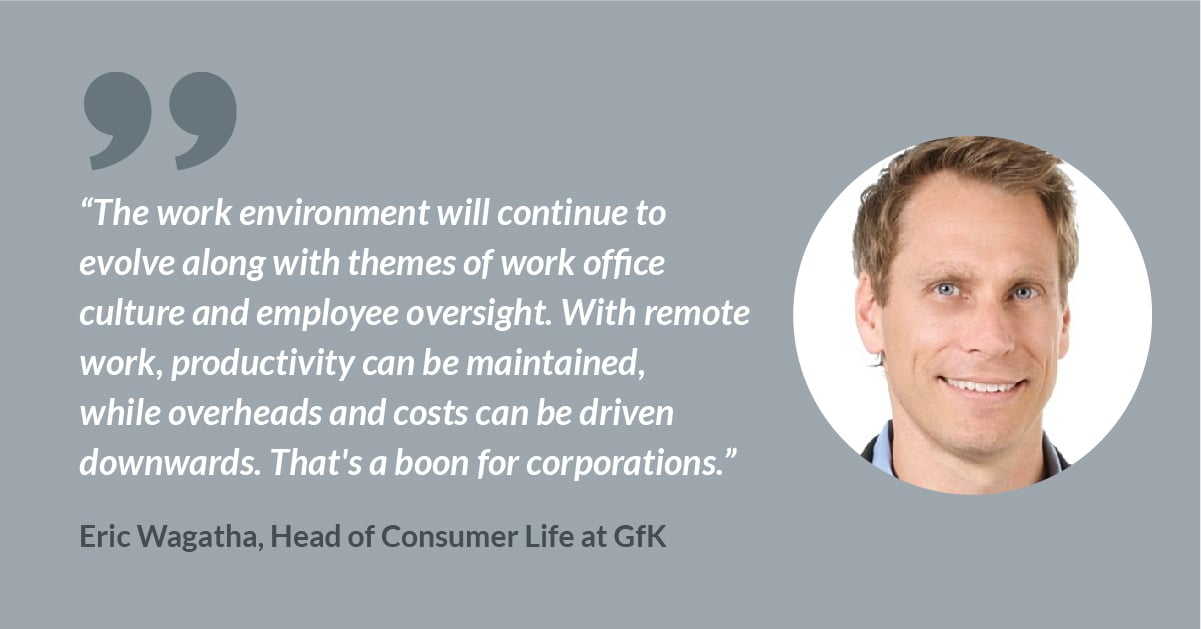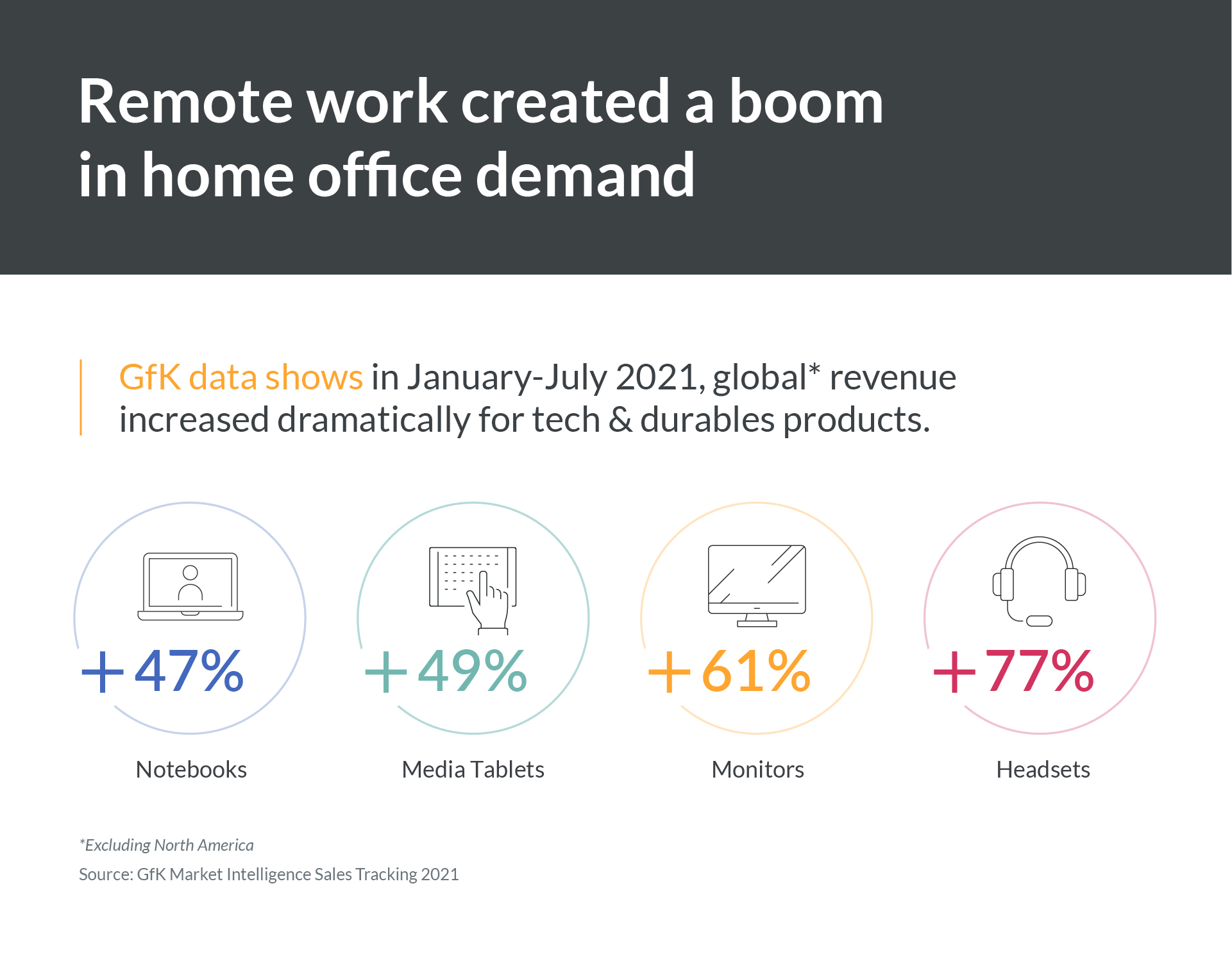Earlier than the COVID-19 pandemic, distant work was a luxurious that many workers used occasionally. As we regulate to the “new regular,” there’s a push to proceed hybrid working, incorporating a combination of in-office and distant work. An inner examine of the 8,500+ GfK workforce in 2021 discovered that workers needed extra flexibility in how and the place they work.
Within the survey, 70% mentioned that WFH provides them the next high quality of life, 50% mentioned their stress ranges have decreased, and 88% are proud of the time saved not commuting. For GfK, distant work has turn into regular. However it’s essential to notice that 62% of GfK employees and 66% of managers mentioned that whereas they would like to work largely from residence, they’d nonetheless like to go to the workplace at the very least someday every week. A hybrid working mannequin is most well-liked by nearly all of workers.
So it’s no shock that the gross sales of residence workplace tools have risen since then. This shift to distant work signifies that WFH customers demand residence workplace tools that helps them work seamlessly, protects their privateness, and replicates in-person interactions. To stay aggressive, manufacturers want to know how one can goal these customers with distant work merchandise that enhance their work lives.

Pre-pandemic, distant work was already surfacing as a world workforce development
Whereas distant work has accelerated throughout the pandemic, it didn’t essentially ignite it. Earlier than COVID-19 lockdowns, 8% of the US workforce labored remotely, and, by Might 2020, that determine had risen to 35% earlier than declining barely to 24% in August. Within the UK, ONS discovered that lower than 30% of the workforce had labored from residence in 2019.
For nearly a decade, specialists have predicted that distant work will turn into commonplace. In 2015, it was forecasted there could be 1 billion digital nomads by 2035, or “location unbiased” employees. The pandemic briefly trumped these figures, because the variety of distant employees in North America and Europe escalated to 125 million folks within the first few months of 2020. This enhance is over 5 instances the variety of folks working from residence earlier than the pandemic. As well as, GfK knowledge reveals that 84% French, 74% British, and 72% Germans who labored from residence in 2020 want to proceed doing so.
Distant work shortly turns into the brand new regular
In 2020, distant working turned the norm in a short time to assist curb the unfold of COVID-19. Sohjin Baek, International Strategic Insights Supervisor at GfK, believes the pandemic switched up shopper buying habits. “Classes like computing, and equipment equivalent to keyboards, mice, and cameras, are booming as a result of individuals are working and studying from residence.”
Know-how and sturdy (T&D) gross sales continued to flourish, driving income development between 2020-2021. Webcams had been up 227%, PC/VOIP headsets 53%, displays 45%, keyboards 33%, mice 28%, cellular PCs 27%, and inkjet printing units 26% (GfK Speaking Tech webinar). The work and study from residence phenomenon created a growth in residence workplace demand.
The rationale for these sharp rises in T&D purchases is as a result of technical and human challenges distant employees face. They want merchandise like mice and keyboards, quick connectivity, and entry to cloud and app companies to add, share, and work collaboratively. To work together with colleagues on video calls, in addition they want know-how and durables, equivalent to webcams and headsets.
GfK knowledge exhibits for the interval of Jan-Jul 2021, in comparison with the identical interval in 2019, world income (excluding North America) elevated dramatically for distant work T&D merchandise: notebooks had been up 47%, media tablets 49%, displays 61%, and headsets 77%.
The affect of telecommuting on shopper spending and innovation
“Earlier than COVID-19, most know-how and durables had been on a downward buying spiral”, says Ines Haaga. “Corporations and types had been promoting fewer T&Ds, particularly in Europe, as a result of we’ve got a very saturated market. Everybody had the gadget already in place, and the substitute cycles had been getting longer.”
Nonetheless, throughout the unprecedented uncertainty, T&D manufacturers met rising shopper necessities. T&D merchandise had their highest demand when customers felt disconnected, and staffing numbers declined. Extra know-how improved folks’s connectivity and helped firms handle while operating on skeleton groups.
In the meantime, rising demand for telecommuting merchandise severely impacted provide chains. As lockdowns occurred globally, factories in Asia shut down. That market holds nearly all of world T&D exports, so manufacturers needed to shift a lot of their manufacturing past China. Costs of distant working merchandise elevated sharply due to Europe and the US shortages. China and India had extra inexpensive options obtainable, however, no matter location and socioeconomic standing, shopper electronics demand rose considerably – all of us wanted it for work.
GfK knowledge reveals that COVID-19 has elevated on-line gross sales for technical shopper items globally by 35%. Whereas corporations like Amazon and Tesla obtained criticism for holding their factories open, COVID-19 additionally sparked innovation. A chief instance is Fetch Robotics, which gives autonomous cellular robots to warehouses, experiencing a 63% enhance in inbound requests from February to March 2020. Innovation is behind WiFi Mesh know-how, which improves Wi-Fi sign energy at residence by way of two or extra units or ‘nodes’. “Distributors are selling WiFi Mesh as a result of you’ve got a number of entry factors in your condo, they usually work seamlessly collectively,” explains Sohjin Baek.
-jpg.jpeg)
What’s subsequent in distant work for know-how and durables?
BBC Worklife analysis discovered that our manner of working has shifted completely. Solely 12% wish to return to full-time workplace work, and 72% need a hybrid remote-office mannequin transferring ahead.
The rise in distant work has implications for the financial system. Distant work searches had been up 360% within the two years to June 2021, in keeping with Glassdoor. Sensible concerns round sure at-home T&D would require innovation as we spend extra time at residence. Quiet robotic vacuums are important and 24/7 T&Ds, like fridges, must be unobtrusive when folks attend webinars or video calls.
Vitality use in T&D additionally requires consideration as home utility prices rise when individuals are home-based. Conversely, if all people labored from residence for simply someday every week, it will save round 1% of worldwide oil consumption for street passenger transport per yr. Regardless of the rise in family power use, the general affect on world CO2 emissions could be an annual decline of 24 million tonnes (Mt) – equal to the majority of Higher London’s annual CO2 emissions.
Lastly, elevated use of know-how and durables will drive future innovation. Efficacy, sturdiness, and power use are current elementary points, however they’ve turn into extra pronounced for the reason that change to a home-based life-style. Manufacturers should deal with how T&Ds carry out below extra pressure whereas tackling the strain to remain forward in a post-pandemic world.
Wish to know extra about what’s subsequent for T&D manufacturers?




